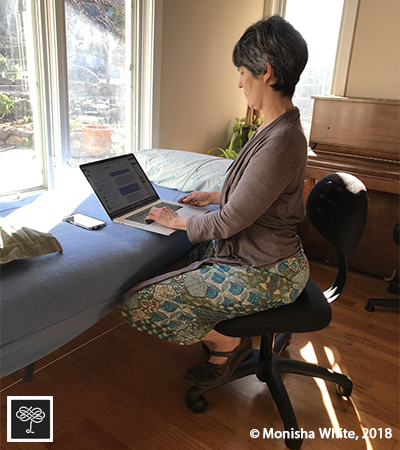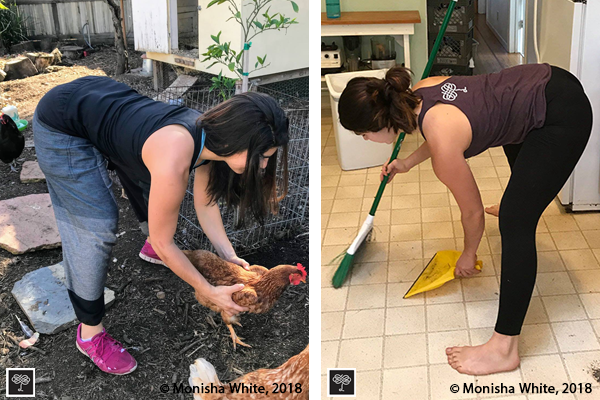What's the Best Way to Stretch Your Hamstrings?
I get this question quite often. The answer is two-fold:
Maintain a healthy baseline length in your hamstrings/glutes by learning to tip your pelvis forward in stacksitting, tallstanding, and glidewalking. When you tuck your pelvis, you bring your ischial tuberosities (sitz bones) in closer to where these muscles attach on the leg. This allows the hamstrings/glutes to adapt to a short resting length. Short hamstrings make you more vulnerable to hamstring injuries when you perform motions that require normal or elongated hamstrings. Tears can happen within the muscle, or, more commonly, where the hamstrings attach to the ischial tuberosities.

Keeping your pelvis tipped forward while sitting helps maintain a healthy glute baseline length. A tipped pelvis while standing maintains a healthy hamstring length.
Hip-hinge to bend, whether you are loading the dishwasher, feeding your pets, or setting the table. In this way, you give your hamstrings a big stretch on and off throughout the day. This is a much more effective way of restoring hamstring flexibility than is compartmentalizing your stretches to an exercise period.

When you use hip-hinging for everyday activities like picking things up and cleaning, you’re turning these activities into a hamstring stretch.
Hamstring injuries heal slowly. Nature was not expecting that we would strain our hamstrings frequently. Hip-hinging would have been a routine activity for our hunter-gatherer ancestors, so hamstrings would have been well-stretched and not prone to tearing. So Nature did not provision the area with a rich blood supply. If a hamstring tears, the lack of circulation in the area makes healing a long process.
By hip-hinging to stretch the hamstrings periodically throughout the day and anteverting (tipping) the pelvis to maintain a healthy hamstring baseline length, you are joining the ranks of your ancestors. You will be able to work, play, and live without being strung up from unnecessary and painful injuries that are a pain in the butt.
If you'd like to learn hip-hinging in our Foundations Course, reach out to a teacher near you. Once you’ve begun anteverting your pelvis and hip-hinging, we’d love to hear: have you noticed any differences in your hamstring flexibility?

Comments
Hi Esther!what about those of
Hi Esther!
what about those of us with severely anterior tilted pelvis? I’m confused about how to walk, stand and sit your way when I do so much to correct the sway back. Thank you!
I'm going to refer you to my
I'm going to refer you to my blog Forward Pelvis: the Good, the Bad, and the Ugly. It's very confusing to wade through the misperceptions around the pelvis, and the pelvis is something you want to get straight (or, rather, anteverted!) It's the foundation on which the rest of your spine is settled. You might want to attend one of our Free Workshops, preferably in person (if you have a teacher in your area) or online. We can show you the difference between anteverting the pevlis and swaying your back. Also, how to fix your sway.
Hi Esther, Thanks for this
Hi Esther,
Thanks for this post. I hadn't realized sitting could also stretch the hamstrings!
I have a question though - is it ever okay to cross your legs when you sit (assuming I am sitting inthe prescribed Gohkale way)?
Isn't it cool that our
It's actually gluteus maximus that gets stretched in sitting with an anteverted pelvis (I've edited the post accordingly). I tend to group gluteus maximus with the hamstrings in my thinking - they're the muscles that, when short, induce poeple to round their backs in bending.
Crossing the legs is fine if you have the flexibility to not have that mess up (tuck / twist) the pelvic position. More about this on our forum here.
I have been practicing the
I have been practicing the hip-hingeing in my daily activities - weeding, dishwasher etc. But I have always had little flexibility through the hamstrings and my hip hingeing requires me to bend my knees to accomodate. I assumed the proper bending was more important than the straightness of my legs, but perhaps that is not the case? Should I attempt to keep my legs straight? My bending of the legs has not seemed to help with any advancement in flexibility, but perhaps that takes more time.
Add New Comment
Login to add commment
Login